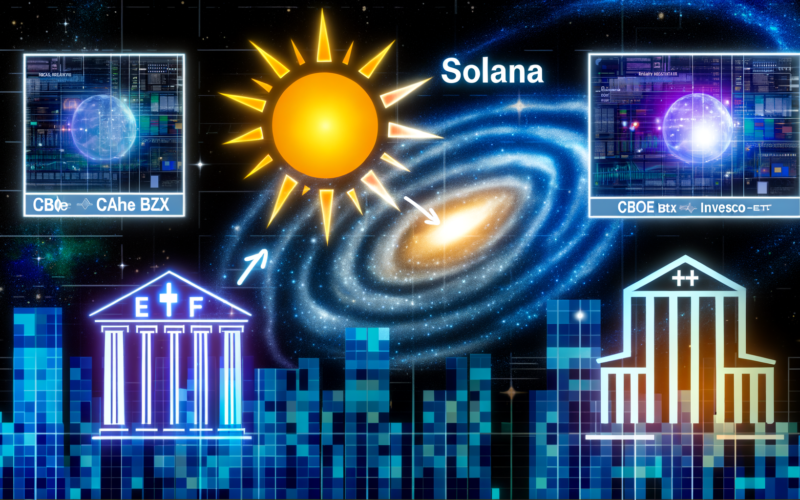Cboe BZX seeks SEC nod for Invesco Galaxy’s Solana ETF amid regulatory delays. Will it shake up the crypto ETF landscape? #Crypto #Solana #ETFs
- Introduction: Navigating Solana’s Journey into Regulated Waters
- The Road to Market: Solana’s Path from Concept to ETF
- Main Insights on Solana ETFs: Bridging Decentralization and Regulation
- Challenges in Solana ETF Adoption: Overcoming Regulatory Hurdles
- Future Outlook: Solana’s Potential Impact on the Financial Ecosystem
- Final Reflections on Solana ETFs: A New Era in Financial Innovation
In the ever-evolving landscape of cryptocurrency, Solana is emerging as a formidable player. As digital assets continue to gain traction among investors, the need for regulated financial products that provide secure access to these assets is more pressing than ever. Enter the proposed Invesco Galaxy Solana ETF, a groundbreaking initiative seeking to integrate Solana into traditional financial markets. This article delves into the intricacies of this proposal, exploring its potential impact on the cryptocurrency sector, the regulatory hurdles it faces, and the broader implications for the future of decentralized finance.
The Road to Market: Solana’s Path from Concept to ETF
Solana’s journey from a decentralized blockchain platform to a potential cornerstone of regulated finance is a testament to its growing influence and technological prowess. Initially conceptualized as a scalable solution for decentralized applications (dApps), Solana’s rapid ascent has been fueled by its high throughput and low transaction costs, characteristics that make it an attractive option for diverse applications. However, transitioning from a decentralized network to a regulated financial product involves navigating a complex web of regulatory requirements and market dynamics.
Main Insights on Solana ETFs: Bridging Decentralization and Regulation
Understanding the Invesco Galaxy Solana ETF Proposal
The proposed ETF marks a significant milestone for Solana, offering investors a regulated avenue to gain exposure to the blockchain’s native token, SOL. By tracking the Lukka Prime Solana Reference Rate, the ETF aims to provide accurate, real-time pricing benchmarks, thus enhancing transparency and trust among investors. Moreover, the ETF’s design allows for both cash and in-kind creation and redemption of shares, offering flexibility and liquidity to investors.
Staking: A Double-Edged Sword
One of the unique aspects of the Solana ETF is its incorporation of staking, a process that could potentially generate additional returns. However, staking also introduces new risks, particularly concerning centralization and market manipulation. As Kadan Stadelmann from Komodo Platform highlights, proof-of-stake networks like Solana can inadvertently concentrate power among a few validators, raising concerns about potential collusion and market volatility.
The regulatory environment for cryptocurrency ETFs remains uncertain, with the U.S. Securities and Exchange Commission (SEC) exercising caution in approving new products. The recent delays in decisions regarding other crypto-related ETFs underscore the challenges that the Invesco Galaxy Solana ETF may face. Despite these hurdles, the proposal’s innovative approach and alignment with pro-crypto sentiments within the SEC could pave the way for future approvals.
Challenges in Solana ETF Adoption: Overcoming Regulatory Hurdles
The road to approval for the Solana ETF is fraught with challenges. Regulatory bodies, wary of the risks associated with decentralized networks, demand rigorous oversight mechanisms to prevent market manipulation and protect investors. The thin trading book of Solana, coupled with its concentrated validator structure, presents additional obstacles that proponents must address to gain regulatory approval.
Future Outlook: Solana’s Potential Impact on the Financial Ecosystem
Looking ahead, the successful approval and implementation of the Solana ETF could set a precedent for future cryptocurrency ETFs, potentially accelerating the integration of digital assets into traditional financial markets. As Solana continues to evolve, its ability to adapt to regulatory demands while maintaining its core principles of decentralization and scalability will be crucial in shaping its long-term impact on the financial ecosystem.
Final Reflections on Solana ETFs: A New Era in Financial Innovation
In conclusion, the Invesco Galaxy Solana ETF represents a bold step toward bridging the gap between decentralized finance and traditional financial markets. By providing regulated access to Solana, the ETF could unlock new opportunities for investors and drive further innovation within the cryptocurrency sector. As the regulatory landscape continues to evolve, the lessons learned from Solana’s journey will undoubtedly influence the future of financial products in the digital age.











